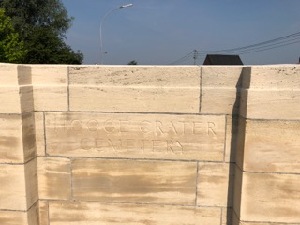Hooge Crater Cemetery: Pauline Priano

Hooge Crater Cemetery: Pauline Priano
Pauline Priano has submitted the following:-
Samuel Smith, one of 10 children of whom only 7 had survived by 1911, was the 3rd born of 5 sons, 3 daughters, 2 gender unknown. His father John George Smith of Sunderland born 1859 married March 24th 1883 at Monkwearmouth, Sunderland, to local girl Jane Oliver Southern, born November 8th 1861 at 14, Peacock Street, North Bishop Wearmouth, County Durham. Their son Edward was born in 1884, Robert 1886, daughter Louise 1887, Elizabeth 1890 and Thomas William in 1891 while they were living at 8, Deptford Road, Bishop Wearmouth, where John George was employed as a pressed glass maker. While Jane was pregnant with their sixth child their daughter Louise died aged 7 years just prior to the birth of Sarah Jane in 1895, Samuel and his younger brother George Henry were born 1st quarter (Jan/Feb/Mar) 1897 and 1902 respectively. In 1891 the family were living at 19, Beech Street, Sunderland, John George had been joined at the glass works by his sons Edward (17) and Robert (16) and by 1911 it provided employment for the entire family with the exception of George Henry (8) who was a scholar and Robert (25) a general labourer. Thomas Smith (19) was an apprentice glassmaker, Samuel (14) was employed in the mould room, Sarah Jane (16) and Elizabeth (21) worked in the glasshouse as washers. They had moved into 3 rooms at 9, Cornwall Street.
When war was declared with Germany Samuel was 17 years of age, still too young to enlist or serve overseas, nether could he enlist when he turned 18 as he was below the required height of 5eet 3 inches. It was not until the first rush of men to enlist had subsided that the government agreed to lower the height for enlistment to 5 feet in January 1915. Samuel was one of the first to enlist at Sunderland, assigned as Private 1462 to the newly formed 19th (Durham Bantams) Battalion Durham Light Infantry. The new recruits assembled at Cocken Hall, home of Lord Durham who had offered his house and estate to the Army for the duration of the war. Some of the men occupied the house, the remainder were in a tented camp in the grounds where trenches had been dug and a firing range had been built to simulate conditions at the front. The Battalion was moved to Masham in North Yorkshire in June 1915 where it joined the 106th Brigade, 35th Division. Once training was complete they transferred to Salisbury Plain and were initially ordered to Egypt in late 1915, however, this was cancelled and they sailed from Southampton, January 31st 1916, landing at Le Havre the following day, concentrating near St. Omer.
The Bantams did not enter the trenches until February 11th 1916 near Neuve Chapelle. July 1st 1916 they moved south to the Somme by rail entering the front line at Longueval, but they did little fighting instead ordered to dig new and repair old trenches whilst being subjected to constant shell fire sustaining heavy casualties.
Private Smith departed with the 35th Division in late August 1916 for the Arras sector where the men were again subjected to heavy shelling and gas attacks which reduced their numbers. The replacements which arrived from England were not as fit as the original Bantams. November 26th 1916 the Germans attacked the Arras front and by the end of the battle the 35th Division was disbanded. The men underwent physical examination and depending on their state of fitness were assigned to fighting units or the Labour Corps. Those sent to the Labour Corps were replaced by men from the disbanded yeomanry regiments, they underwent a quick training course at Divisional HQ before returning to front line duties.
During 1917 they were in action during the pursuit to the Hindenburg Line and fought at The Battle of Passchendaele, July 31st-November 10th 1917.
Private Samuel Smith was reported as missing and after extensive investigations as to his whereabouts was struck off and recorded as having died on or since September 23rd 1917. After the Armistice of November 11th 1918 the clearing of the battlefields began and at the request of the French and Belgium governments small concentrations were brought into larger cemeteries. The remains of Private 1463 Samuel Smith Durham Light Infantry were discovered, exhumed and brought into Hooge Cemetery, West Vlaanderen, east of Ypres in Belgium, for re-burial with all military honours by an Army Chaplain. He is at rest, grave X. E. 1, Samuel was 20 years of age and single. The CWGC have adopted the date of September 23th 1917 as the official date of his demise.
Having nominated his mother Jane as his sole legitimate beneficiary she received all monies due to him from the Army, a pension and his awards of the British War Medal and Victory Medal sent to her at Trimdon Street, Sunderland, County Durham.
Samuelís elder brother Robert Smith died before him, at home in England, January 10th 1917 and is considered by the CWGC as a casualty of war. He left a wife and 2 children, a son aged 3 and a 1-year-old daughter.
Their mother Jane Oliver Smith nee Southern died in 1920 aged 58 years, John George Smith aged 65 years in 1926, both registered in the district of Sunderland.
In Godís safe keeping. Rest In Peace.
Samuel Smith is remembered in Sunderland in S140.048 part 1 page 39
He is also remembered in The DLI Book of Remembrance page 259.

